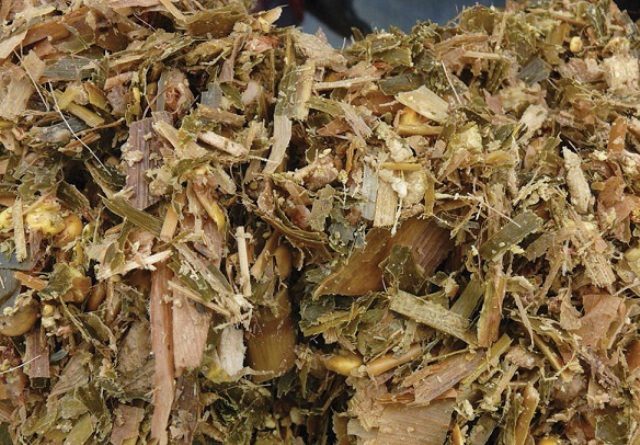( Update: 22/04/2019 )
Corn stalks are a source of food with a very high nutrient content, it is used as food for animals such as buffaloes, cows, deer ... At harvest, because cows and buffaloes are not eaten, corn stalks are often discarded or used as fuel leads to wastefulness, not taking full advantage of its use.

To help farmers thoroughly utilize corn stalks after harvest and use them as food for their livestock. Tuan Tu Investment Joint Stock Company would like to share the corn stalk method and corn byproducts after corn harvest.
- Drying wilt of corn stalks: Normally, we should dry wilt for about half a day depending on the weather, we should not dry too much before chopping and put into the hole. While drying, every 2 hours need to be turned once for the tree to wither evenly, avoiding the condition that the upper layer is dry but still fresh. Usually, every 4 - 6 hours after drying, randomly cut 1 corn leaf (about 3 - 4 times the same), clutching in the palm. After opening, if you see the folds on the leaves leaving the sugar unclear and moist but not leaking or the leaves are not broken, then their moisture reaches the ideal state (65-70%) for silage.
- Ratio of raw materials based on the following table:
| Material name | Composition ratio (Kg) |
| Fresh corn / corn husks have withered | 100 |
| Rice bran | 4 |
| Tapioca | 4 |
| Molasses | 10 (For corn and corn, corn and corn have been harvested and the corn is harvested dry) |
| 5 (For corn harvested when corn is waxed) | |
| Clean water | 10 – 20 |
| Salt | 0,5 |
Shred corn stalks into small pieces from 1 to 5 cm. This is a time consuming process because the number of corn stalks is quite large. People refer to the elephant grass hash machine , the 3A4Kw corn stalk , which is a product line that is used by many relatives as well as private livestock farms for chopping elephant grass, corn stalks and other agricultural residues.
After hashing the corn stalks, people mix the remaining ingredients in proportion to the table above. When the water is mixed, it is necessary to use 1 ozone with a capacity of 10 liters. Take 5 liters of molasses mixed with 5 liters of cold water, paying attention to stirring and evenly spray each layer of corn into the hole. It is necessary to determine a sufficient amount of molasses solution for the entire food layer in the compost pit.
Clear the compost hole, spread 1 layer of rock and gravel to the bottom of the hole and spread a layer of dry straw 10cm thick on top. Compressed each layer 15-20 cm in thickness until the end of the compost material. Then, cover the compost pit with soil layer 30 - 40 cm thick. Carefully covered with plastic.
People must regularly check around the compost and surrounding walls to see if there is any damage.
Regularly check around composting pit, wall into compost to see if there is any damage or breakage. Plunge holes to get food in the basic positions such as walls, bottom of pit ... to check silage to detect the quality of silage for timely processing.
About 72 hours after closing the compost pit, anaerobic fermentation stops. Corn or corn by-products will turn into silage. At that time, start a stable period, lasting about 6-7 weeks. Thus, this silage can feed ruminants starting from the 8th week. This feed is preserved for cattle to eat gradually in 6 months. Each time the food is taken out, it must be covered carefully, avoiding water infiltration into the compost pit.
- The pit must be solid, the bottom of the pit must be flat, the pit has at least 2 vertical surfaces and the pit is designed, choose the position so that it does not stagnate water, stagnant water, absorb water.
- Determination of compaction: Arrange 1 bar on the inside of the compost hole to mark the distance of 15-20 cm from the bottom of the pit. When putting food in the hole to the marked mark, stamp it until the food layer drops to 7-10 cm. Continue to trace the inner wall of the hole at a distance of 15-20 cm, calculated from the compacted layer of food. The chopped food has been mixed with ingredients into the compost pit and marked corresponding to the width of 5 fingers closed. Do so until the pit is full.
With the sharing of silage method of corn stems, it is hoped to help people in taking advantage of this source of by-products to serve the raising effectively.
Happy successful people!